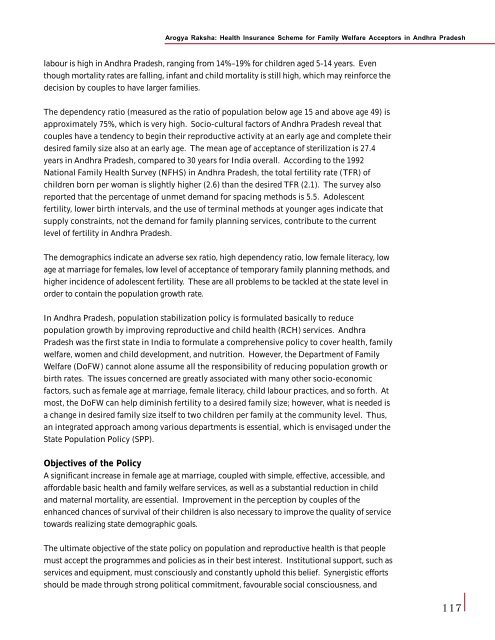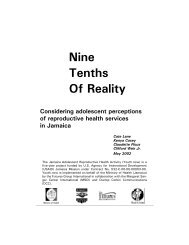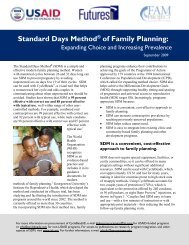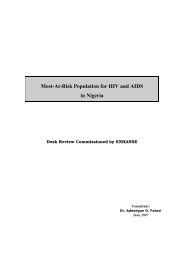Health Policy Issues and Health Programmes in ... - Amazon S3
Health Policy Issues and Health Programmes in ... - Amazon S3
Health Policy Issues and Health Programmes in ... - Amazon S3
- No tags were found...
You also want an ePaper? Increase the reach of your titles
YUMPU automatically turns print PDFs into web optimized ePapers that Google loves.
Arogya Raksha: <strong>Health</strong> Insurance Scheme for Family Welfare Acceptors <strong>in</strong> Andhra Pradeshlabour is high <strong>in</strong> Andhra Pradesh, rang<strong>in</strong>g from 14%–19% for children aged 5-14 years. Eventhough mortality rates are fall<strong>in</strong>g, <strong>in</strong>fant <strong>and</strong> child mortality is still high, which may re<strong>in</strong>force thedecision by couples to have larger families.The dependency ratio (measured as the ratio of population below age 15 <strong>and</strong> above age 49) isapproximately 75%, which is very high. Socio-cultural factors of Andhra Pradesh reveal thatcouples have a tendency to beg<strong>in</strong> their reproductive activity at an early age <strong>and</strong> complete theirdesired family size also at an early age. The mean age of acceptance of sterilization is 27.4years <strong>in</strong> Andhra Pradesh, compared to 30 years for India overall. Accord<strong>in</strong>g to the 1992National Family <strong>Health</strong> Survey (NFHS) <strong>in</strong> Andhra Pradesh, the total fertility rate (TFR) ofchildren born per woman is slightly higher (2.6) than the desired TFR (2.1). The survey alsoreported that the percentage of unmet dem<strong>and</strong> for spac<strong>in</strong>g methods is 5.5. Adolescentfertility, lower birth <strong>in</strong>tervals, <strong>and</strong> the use of term<strong>in</strong>al methods at younger ages <strong>in</strong>dicate thatsupply constra<strong>in</strong>ts, not the dem<strong>and</strong> for family plann<strong>in</strong>g services, contribute to the currentlevel of fertility <strong>in</strong> Andhra Pradesh.The demographics <strong>in</strong>dicate an adverse sex ratio, high dependency ratio, low female literacy, lowage at marriage for females, low level of acceptance of temporary family plann<strong>in</strong>g methods, <strong>and</strong>higher <strong>in</strong>cidence of adolescent fertility. These are all problems to be tackled at the state level <strong>in</strong>order to conta<strong>in</strong> the population growth rate.In Andhra Pradesh, population stabilization policy is formulated basically to reducepopulation growth by improv<strong>in</strong>g reproductive <strong>and</strong> child health (RCH) services. AndhraPradesh was the first state <strong>in</strong> India to formulate a comprehensive policy to cover health, familywelfare, women <strong>and</strong> child development, <strong>and</strong> nutrition. However, the Department of FamilyWelfare (DoFW) cannot alone assume all the responsibility of reduc<strong>in</strong>g population growth orbirth rates. The issues concerned are greatly associated with many other socio-economicfactors, such as female age at marriage, female literacy, child labour practices, <strong>and</strong> so forth. Atmost, the DoFW can help dim<strong>in</strong>ish fertility to a desired family size; however, what is needed isa change <strong>in</strong> desired family size itself to two children per family at the community level. Thus,an <strong>in</strong>tegrated approach among various departments is essential, which is envisaged under theState Population <strong>Policy</strong> (SPP).Objectives of the <strong>Policy</strong>A significant <strong>in</strong>crease <strong>in</strong> female age at marriage, coupled with simple, effective, accessible, <strong>and</strong>affordable basic health <strong>and</strong> family welfare services, as well as a substantial reduction <strong>in</strong> child<strong>and</strong> maternal mortality, are essential. Improvement <strong>in</strong> the perception by couples of theenhanced chances of survival of their children is also necessary to improve the quality of servicetowards realiz<strong>in</strong>g state demographic goals.The ultimate objective of the state policy on population <strong>and</strong> reproductive health is that peoplemust accept the programmes <strong>and</strong> policies as <strong>in</strong> their best <strong>in</strong>terest. Institutional support, such asservices <strong>and</strong> equipment, must consciously <strong>and</strong> constantly uphold this belief. Synergistic effortsshould be made through strong political commitment, favourable social consciousness, <strong>and</strong>117







